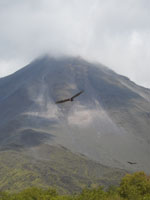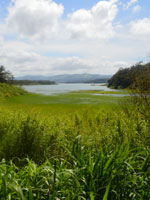

|
I left Puerto San Luis in the morning and started out on the winding road that leads to Arenal Volcano. This is one of the most popular tourist destinations in Costa Rica, but as recently as the 1990s, much of this road was not paved. It is a spectacular road, but narrow and precarious in places that have no shoulder and a steep drop off. It crosses numerous one-lane bridges, where drivers have to take care to notice the Ceda el Paso (Yield) signs to give the right of way to oncoming traffic. The road winds around Lago Arenal and has a number of beautiful places to pull over and take in all of the majestic landscape of water, mountains, and greenery. As I got up into the high country, I began to notice the rows of windmills along the ridgetops. Costa Rica already generates 95% of its electricity from renewable energy sources and is on track to become the world’s first carbon-free economy. The country's commitment to reducing fossil fuels, as well as its strong protections for national parks and biological reserves, make it one of the greenest countries in the world. Approximately 60 kilometers from Puerto San Luis, I reached the entrance to the Arenal Volcano National Park. I talked to the rangers at the entrance station and they gave me a map of the hiking trails. My legs are sore and my feet are blistered from all the beach patrolling I did over the past nine days, but I couldn't resist a hike up to the overview of the volcano. It was an easy two-kilometer hike up to the overview, through lush rain forest that offered cooling shade in the mid-afternoon. I came around a corner and found myself face to face with a large bird in the middle of the trail. About the size of a wild turkey, it had an elaborate crown of feathers on its head, like a queen of the forest. I found out through my friend Ben Lamb that this was a female currasow, a common bird of the Costa Rican rain forests. She walked ahead of me on the trail for a while, then disappeared into the dense brush alongside the trail. I came to the turnoff for the Coladas de Lava, a lava flow dating from 1992. This lava flow, which is 250 meters wide (820 feet), provides an amazingly close-up overlook of Arenal Volcano. The perfectly symmetrical, conical-shaped mountain rises above the lava flow, inspiring feelings of reverence and awe. I had seen a large number of tourists coming back along the trail as I hiked up it, but when I got to the overlook, I had the place to myself for about ten minutes. It was nice to sit in the middle of the old lava flow and look up at the volcano, contemplating its majesty in complete solitude. From the overlook, I hiked back via the Sendero del Ceibo, which allowed me to do a loop hike that totaled about five kilometers. The hike back passed by a massive ceibo tree, more than 120 feet high, estimated to be more than 400 years old. It had the girth of a sequoia tree, with long buttressing roots that stretched out across the jungle floor. I continued along the trail past the ceibo tree and soon came upon another Currasow, this time a male with a bright yellow beak. Like his female counterpart, he accompanied me along the trail for a bit, then dashed off into the brush. My next encounter was with a coati, that was completely oblivious to me as he dug up around the roots of a tree. A wild hike. After the hike, I continued along the road to La Fortuna, the center of the tourist industry around Arenal Volcano. It is a gigantic industry in this part of Costa Rica, with vast hotels, thermal spas, restaurants ranging from típico to Burger King, and an endless variety of tours, butterfly farms, eco-parks, and canopy trips available for those who need to be guided around. At this point, I just wanted to relax and rest my weary legs and feet. |
||||
|
||||
|
© 2015 Michael Hanrahan
|